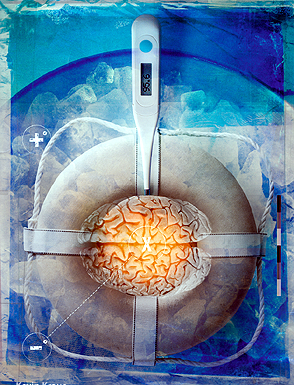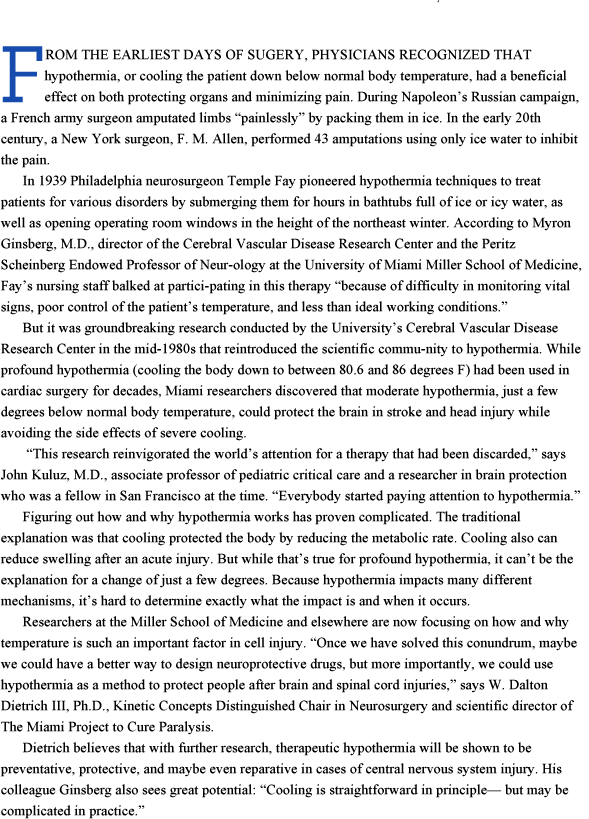 |
 |
|
 |
||
 |
||
Protecting the Brain
 |
||
 |
In 1985 a group of researchers including Ginsberg, Dietrich, Raul Busto, and the late Israeli scientist Mordecai Globus, M.D., were working on studies of stroke and cerebral ischemia (lack of blood flow to the brain) at the Cerebral Vascular Disease Research Center. Busto, the center’s longtime research supervisor, suspected that mild, previously unobserved cooling of the brain during experimental cerebral ischemia might offer protection. So the research team performed a series of experiments that carefully measured and controlled the temperature of the body and brain during an ischemic insult. They found severe brain injury would occur if the temperature of the brain was maintained at normal levels during the insult. But reducing the temperature of the brain just a few degrees dramatically protected the brain. While profound hypothermia also protected the brain, it resulted in more side effects, such as infection and cardiac problems. But just dropping the temperature a few degrees worked, with less potential for unwarranted side effects. Mild to moderate hypothermia effectively protected the brain when it was induced during or shortly after cerebral ischemia.
Under the lead authorship of Busto, the researchers published these landmark observations in a seminal article in the Journal of Cerebral Blood Flow and Metabolism in 1987—an article that grabbed the attention of a number of scientists working in the field and helped to transform the direction of ischemia research. According to Ginsberg, one of the implications of these studies was that many previous experimental brain ischemia studies turned out to be invalid or misleading because brain temperature was not being measured or controlled.
For example, there had been interest in protecting the brain by giving barbiturates, and it was thought that the barbiturates themselves were neuroprotective. But barbiturates cause the body and brain temperature to drop, so it turned out that the “protective” element of the barbiturates was due to the hypothermia itself. The measurement of brain temperature is now standard practice in experimental ischemia studies. Globus made the important discovery that one of the mechanisms by which moderate hypothermia protected the brain was by inhibiting the release of potentially damaging chemicals, called “excitotoxic” neurotransmitters, from brain cells.
After their initial breakthrough, the Cerebral Vascular Disease Research Center continued to focus on studies “to define the benefit of hypothermia in different insults, ranging from focal ischemic stroke (damage to a restricted portion of the brain, such as occurs in patients with stroke), brain damage after cardiac arrest, and traumatic brain injury. Hypothermia is protective across all of those conditions,” Ginsberg says.
From Laboratory to Clinic
A major clinical triumph of moderate hypothermia came in 2002 with the publication in The New England Journal of Medicine of the results of two independent randomized clinical trials in which patients who had suffered cardiac arrest—which often leads to irreversible injury of regions of the brain important for memory and cognition—were treated with either moderate hypothermia or were maintained at normal temperature. Both studies convincingly showed that treatment with moderate hypothermia led to greater survival and improved neurological outcome. “Parts of the brain are very sensitive to a transient ischemic event,” Dietrich says. “The findings from the multicenter trials demonstrate that hypothermia protects these people. Importantly, hypothermia is the first neuroprotectant that has been successfully transferred from the laboratory to the clinic.”  Based on the results of those successful studies, many
researchers, including Ginsberg, believe that hypothermic treatment should
now become the standard of
care for patients who are resuscitated after cardiac arrest. Others would argue
for more clinical investigation.
Based on the results of those successful studies, many
researchers, including Ginsberg, believe that hypothermic treatment should
now become the standard of
care for patients who are resuscitated after cardiac arrest. Others would argue
for more clinical investigation.
While hypothermia has been successful in several individual institutional traumatic brain injury (TBI) studies, a multicenter trial cooling patients with severe brain trauma was unable to show any benefit of cooling. However, that study, in retrospect, was not optimally designed, Ginsberg says, and neurosurgeons are currently designing improved trials to reassess hypothermia in brain trauma. Dietrich points out that an analysis conducted after the publication of the study showed that factors such as age and the timing of the cooling are important considerations in the success of hypothermia. Recently, Helen Bramlett, Ph.D., research assistant professor of neurological surgery at The Miami Project, demonstrated that gender is yet another important factor in determining the benefits of post-traumatic hypothermia. Bramlett discovered that hypothermia worked in the male rat models of TBI, but not in female rats.
One area of clinical use where hypothermia may lose ground is in cardiac surgery, where cooling has been “a religion to heart surgeons” for years, says Tomas A. Salerno, M.D., professor of surgery and chief of the Division of Cardiothoracic Surgery.
“Everybody was cooling patients because hypothermia has been associated with heart surgery since the beginning of heart surgery. Our group questions why we cool all these patients. We came to the conclusion that you don’t have to in many cases,” Salerno says.
“I don’t use hypothermia in heart surgery as a routine; I use hypothermia in the case when I have to have circulatory arrest,” Salerno says, citing the side effects of hypothermia, such as an increased risk of infection and of generalized bleeding. Still, Salerno says that hypothermia is necessary to protect the brain in some surgeries: “It’s used primarily in situations where you’re involving arch vessels—aneurysms of the ascending aorta, dissections of the aorta, some of the congenital abnormalities in children that you have to correct and stop the circulation. In those instances, the colder you are, the safer it is for the brain.”
Preventing Injury After Injury
The other end of the spectrum in body temperature is hyperthermia, or fever. Animal studies at the Cerebral Vascular Disease Research Center and The Miami Project have clearly shown that even a few degrees of elevated brain temperature could be devastating to a patient who has suffered cardiac arrest, stroke, or brain or spinal cord trauma. “Clinical studies have shown that for every degree of temperature elevation in the acute stages, there’s a 10 percent worsening of outcome in terms of neurologic function,” Ginsberg says. It is critically important to reduce fever whenever it occurs in patients with injured brains.
One of the most serious—and least understood—aspects of spinal cord injury is the risk of “secondary” injury. After a brain or spinal cord injury occurs, nerve cells that survive the initial injury are at risk for further damage.
Researchers at The Miami Project are assessing several different applications for hypothermia to prevent secondary injuries, such as selectively cooling an injured area of the spinal cord. “We have protected spinal cord tissue from subsequent injury by cooling in experimental studies, thus showing that, in most instances, if you can decrease the amount of structural damage to the brain and spinal cord, you can improve functional outcome with less neurological deficit,” Dietrich says.
Rather than maintaining hypothermia by cooling the entire body using cooling blankets, researchers are also looking at ways to cool a specific area. Kuluz and John Ragheb, M.D., associate professor of clinical neurosurgery, director of the Division of Pediatric Neurosurgery, and co-director of the pediatric neurotrauma program at UM/Jackson Memorial Medical Center, are participating in a multicenter trial of hypothermia in children after head injury. The study is moving into its third phase of testing. “It’s safe, it works—we just don’t know if it’s effective,” Kuluz says.
Kuluz has also created and is studying a helmet that can fit over the head and cool the brain. “We’re currently using the brain cooling helmet in children who have elevated brain temperatures following head trauma. We use it for patients who have severe swelling and high brain temperature to keep the temperature within normal limits,” Kuluz says. While the helmet has shown that it can cool the brain while maintaining normal body temperature, further testing is needed to see if the helmet can also improve the outcome for selected patients.
There are also implantable cooling catheters on the market that are being used in experimental trials to cool the blood without the discomfort of surface cooling. “Internal cooling methods should allow for the more critical maintenance of hypothermia levels during and after the cooling period,” Dietrich says.
Investigators expect clinical progress in all these approaches to hypothermia to be slow, but steady. “Conducting a large clinical trial is like watching grass grow,” Ginsberg says. “But if the results are positive, it is wonderful.”